Child Development: Analysis of Module 4 and 5 Discussions - University
VerifiedAdded on 2020/04/21
|10
|2237
|27
Homework Assignment
AI Summary
This assignment delves into key aspects of child development, focusing on discussions from Modules 4 and 5. It explores the interconnectedness of learning and play in early childhood, emphasizing their roles in cognitive, emotional, and social development. The paper examines the nature versus nurture debate and how stress impacts a child's development, including the influence of curriculum and environmental factors. Furthermore, the assignment analyzes the development of cognition, language, and motor skills, highlighting their interdependencies and the influence of gender. Finally, it discusses social and emotional development milestones and the importance of creating a supportive environment for children. The paper references various studies and initiatives to support the presented arguments.
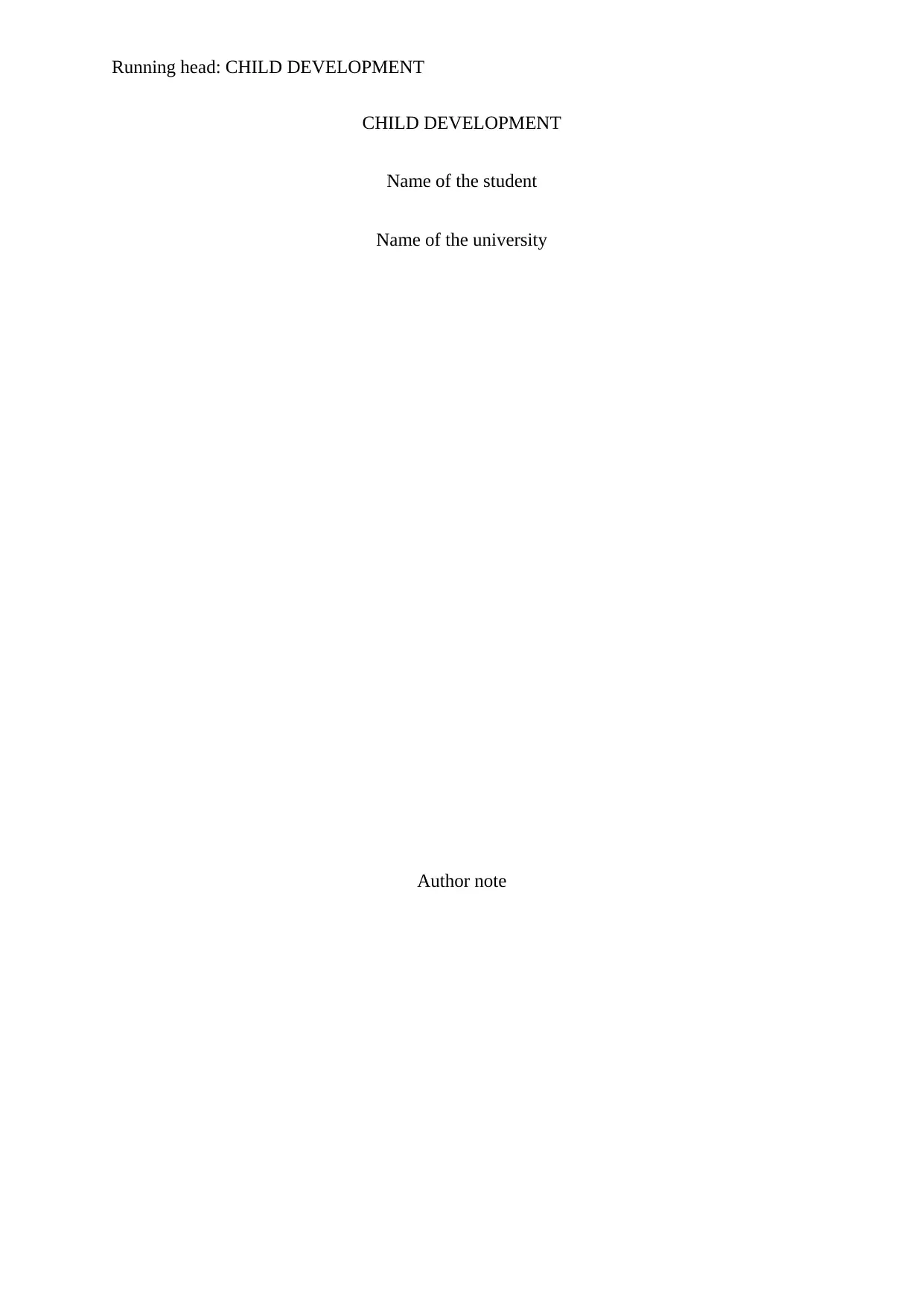
Running head: CHILD DEVELOPMENT
CHILD DEVELOPMENT
Name of the student
Name of the university
Author note
CHILD DEVELOPMENT
Name of the student
Name of the university
Author note
Paraphrase This Document
Need a fresh take? Get an instant paraphrase of this document with our AI Paraphraser
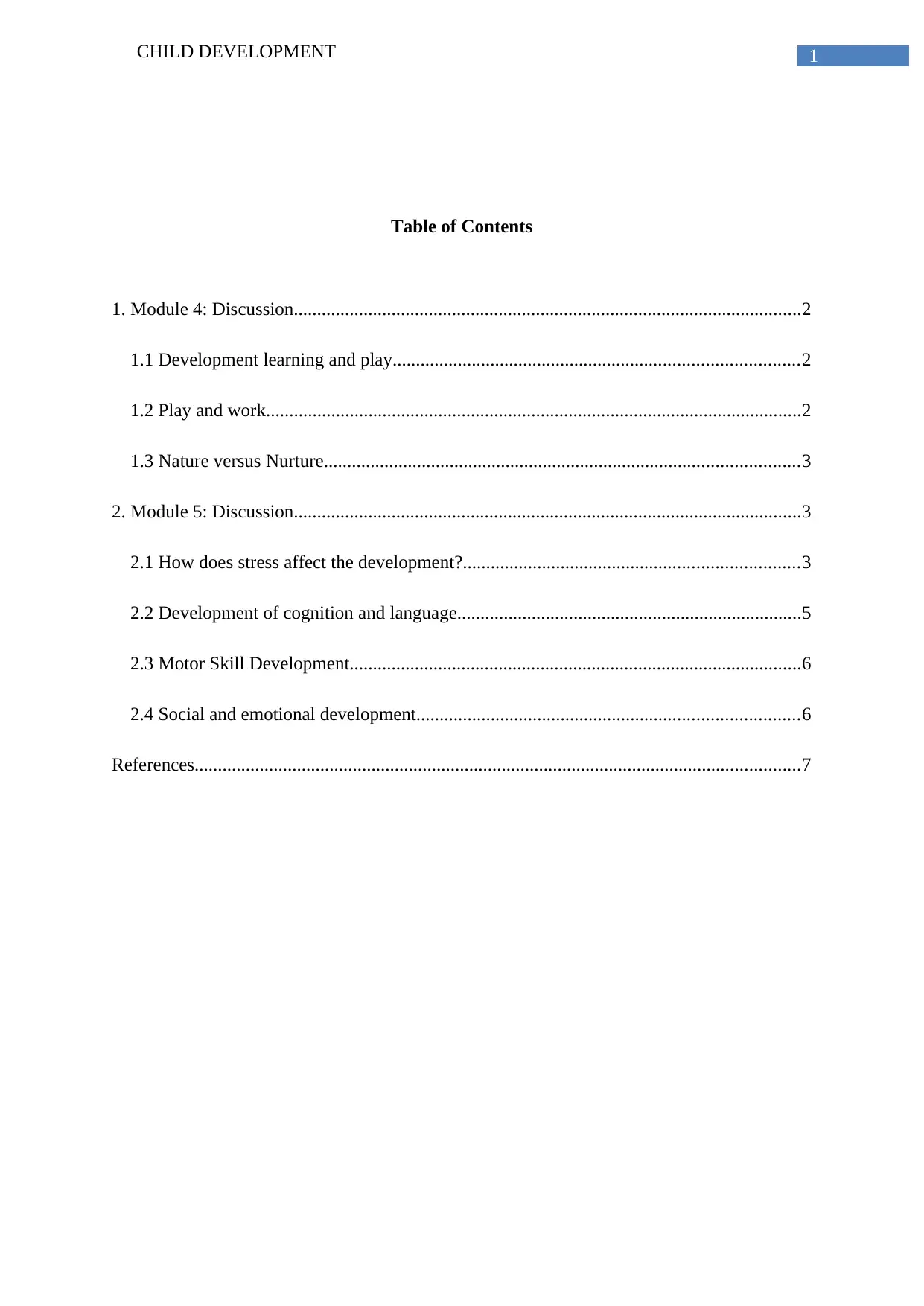
1CHILD DEVELOPMENT
Table of Contents
1. Module 4: Discussion.............................................................................................................2
1.1 Development learning and play.......................................................................................2
1.2 Play and work...................................................................................................................2
1.3 Nature versus Nurture......................................................................................................3
2. Module 5: Discussion.............................................................................................................3
2.1 How does stress affect the development?........................................................................3
2.2 Development of cognition and language..........................................................................5
2.3 Motor Skill Development.................................................................................................6
2.4 Social and emotional development..................................................................................6
References..................................................................................................................................7
Table of Contents
1. Module 4: Discussion.............................................................................................................2
1.1 Development learning and play.......................................................................................2
1.2 Play and work...................................................................................................................2
1.3 Nature versus Nurture......................................................................................................3
2. Module 5: Discussion.............................................................................................................3
2.1 How does stress affect the development?........................................................................3
2.2 Development of cognition and language..........................................................................5
2.3 Motor Skill Development.................................................................................................6
2.4 Social and emotional development..................................................................................6
References..................................................................................................................................7
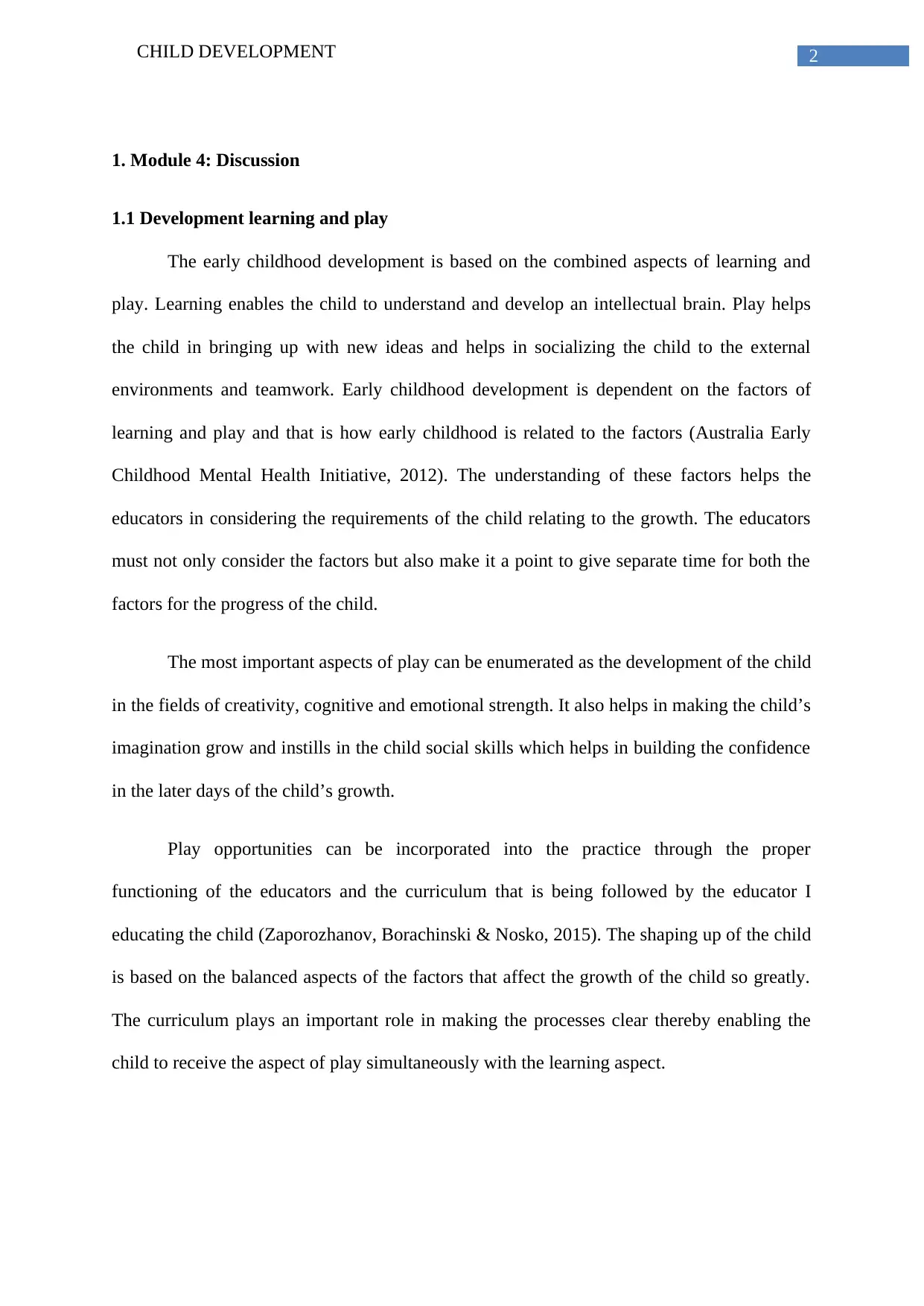
2CHILD DEVELOPMENT
1. Module 4: Discussion
1.1 Development learning and play
The early childhood development is based on the combined aspects of learning and
play. Learning enables the child to understand and develop an intellectual brain. Play helps
the child in bringing up with new ideas and helps in socializing the child to the external
environments and teamwork. Early childhood development is dependent on the factors of
learning and play and that is how early childhood is related to the factors (Australia Early
Childhood Mental Health Initiative, 2012). The understanding of these factors helps the
educators in considering the requirements of the child relating to the growth. The educators
must not only consider the factors but also make it a point to give separate time for both the
factors for the progress of the child.
The most important aspects of play can be enumerated as the development of the child
in the fields of creativity, cognitive and emotional strength. It also helps in making the child’s
imagination grow and instills in the child social skills which helps in building the confidence
in the later days of the child’s growth.
Play opportunities can be incorporated into the practice through the proper
functioning of the educators and the curriculum that is being followed by the educator I
educating the child (Zaporozhanov, Borachinski & Nosko, 2015). The shaping up of the child
is based on the balanced aspects of the factors that affect the growth of the child so greatly.
The curriculum plays an important role in making the processes clear thereby enabling the
child to receive the aspect of play simultaneously with the learning aspect.
1. Module 4: Discussion
1.1 Development learning and play
The early childhood development is based on the combined aspects of learning and
play. Learning enables the child to understand and develop an intellectual brain. Play helps
the child in bringing up with new ideas and helps in socializing the child to the external
environments and teamwork. Early childhood development is dependent on the factors of
learning and play and that is how early childhood is related to the factors (Australia Early
Childhood Mental Health Initiative, 2012). The understanding of these factors helps the
educators in considering the requirements of the child relating to the growth. The educators
must not only consider the factors but also make it a point to give separate time for both the
factors for the progress of the child.
The most important aspects of play can be enumerated as the development of the child
in the fields of creativity, cognitive and emotional strength. It also helps in making the child’s
imagination grow and instills in the child social skills which helps in building the confidence
in the later days of the child’s growth.
Play opportunities can be incorporated into the practice through the proper
functioning of the educators and the curriculum that is being followed by the educator I
educating the child (Zaporozhanov, Borachinski & Nosko, 2015). The shaping up of the child
is based on the balanced aspects of the factors that affect the growth of the child so greatly.
The curriculum plays an important role in making the processes clear thereby enabling the
child to receive the aspect of play simultaneously with the learning aspect.
⊘ This is a preview!⊘
Do you want full access?
Subscribe today to unlock all pages.

Trusted by 1+ million students worldwide
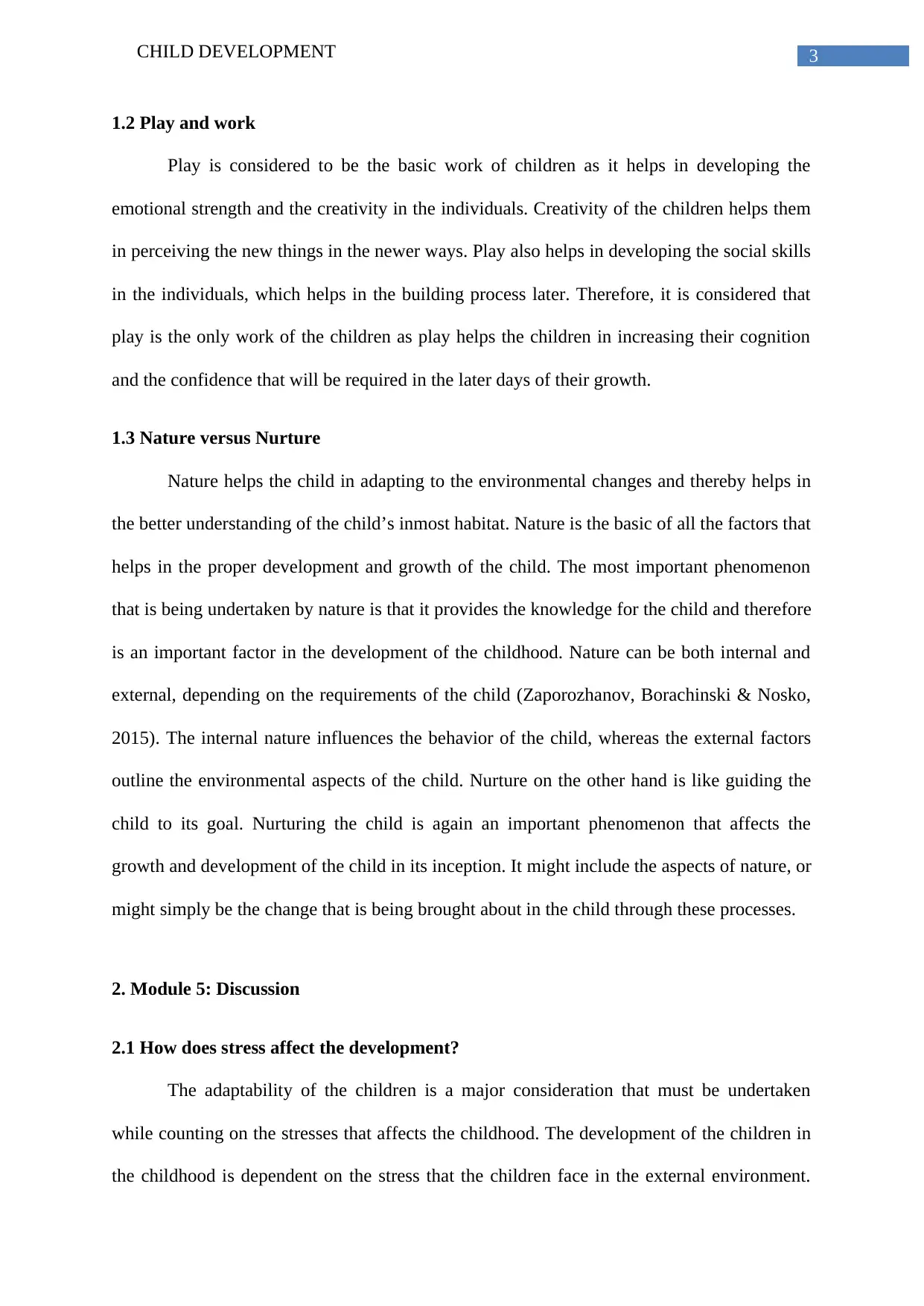
3CHILD DEVELOPMENT
1.2 Play and work
Play is considered to be the basic work of children as it helps in developing the
emotional strength and the creativity in the individuals. Creativity of the children helps them
in perceiving the new things in the newer ways. Play also helps in developing the social skills
in the individuals, which helps in the building process later. Therefore, it is considered that
play is the only work of the children as play helps the children in increasing their cognition
and the confidence that will be required in the later days of their growth.
1.3 Nature versus Nurture
Nature helps the child in adapting to the environmental changes and thereby helps in
the better understanding of the child’s inmost habitat. Nature is the basic of all the factors that
helps in the proper development and growth of the child. The most important phenomenon
that is being undertaken by nature is that it provides the knowledge for the child and therefore
is an important factor in the development of the childhood. Nature can be both internal and
external, depending on the requirements of the child (Zaporozhanov, Borachinski & Nosko,
2015). The internal nature influences the behavior of the child, whereas the external factors
outline the environmental aspects of the child. Nurture on the other hand is like guiding the
child to its goal. Nurturing the child is again an important phenomenon that affects the
growth and development of the child in its inception. It might include the aspects of nature, or
might simply be the change that is being brought about in the child through these processes.
2. Module 5: Discussion
2.1 How does stress affect the development?
The adaptability of the children is a major consideration that must be undertaken
while counting on the stresses that affects the childhood. The development of the children in
the childhood is dependent on the stress that the children face in the external environment.
1.2 Play and work
Play is considered to be the basic work of children as it helps in developing the
emotional strength and the creativity in the individuals. Creativity of the children helps them
in perceiving the new things in the newer ways. Play also helps in developing the social skills
in the individuals, which helps in the building process later. Therefore, it is considered that
play is the only work of the children as play helps the children in increasing their cognition
and the confidence that will be required in the later days of their growth.
1.3 Nature versus Nurture
Nature helps the child in adapting to the environmental changes and thereby helps in
the better understanding of the child’s inmost habitat. Nature is the basic of all the factors that
helps in the proper development and growth of the child. The most important phenomenon
that is being undertaken by nature is that it provides the knowledge for the child and therefore
is an important factor in the development of the childhood. Nature can be both internal and
external, depending on the requirements of the child (Zaporozhanov, Borachinski & Nosko,
2015). The internal nature influences the behavior of the child, whereas the external factors
outline the environmental aspects of the child. Nurture on the other hand is like guiding the
child to its goal. Nurturing the child is again an important phenomenon that affects the
growth and development of the child in its inception. It might include the aspects of nature, or
might simply be the change that is being brought about in the child through these processes.
2. Module 5: Discussion
2.1 How does stress affect the development?
The adaptability of the children is a major consideration that must be undertaken
while counting on the stresses that affects the childhood. The development of the children in
the childhood is dependent on the stress that the children face in the external environment.
Paraphrase This Document
Need a fresh take? Get an instant paraphrase of this document with our AI Paraphraser
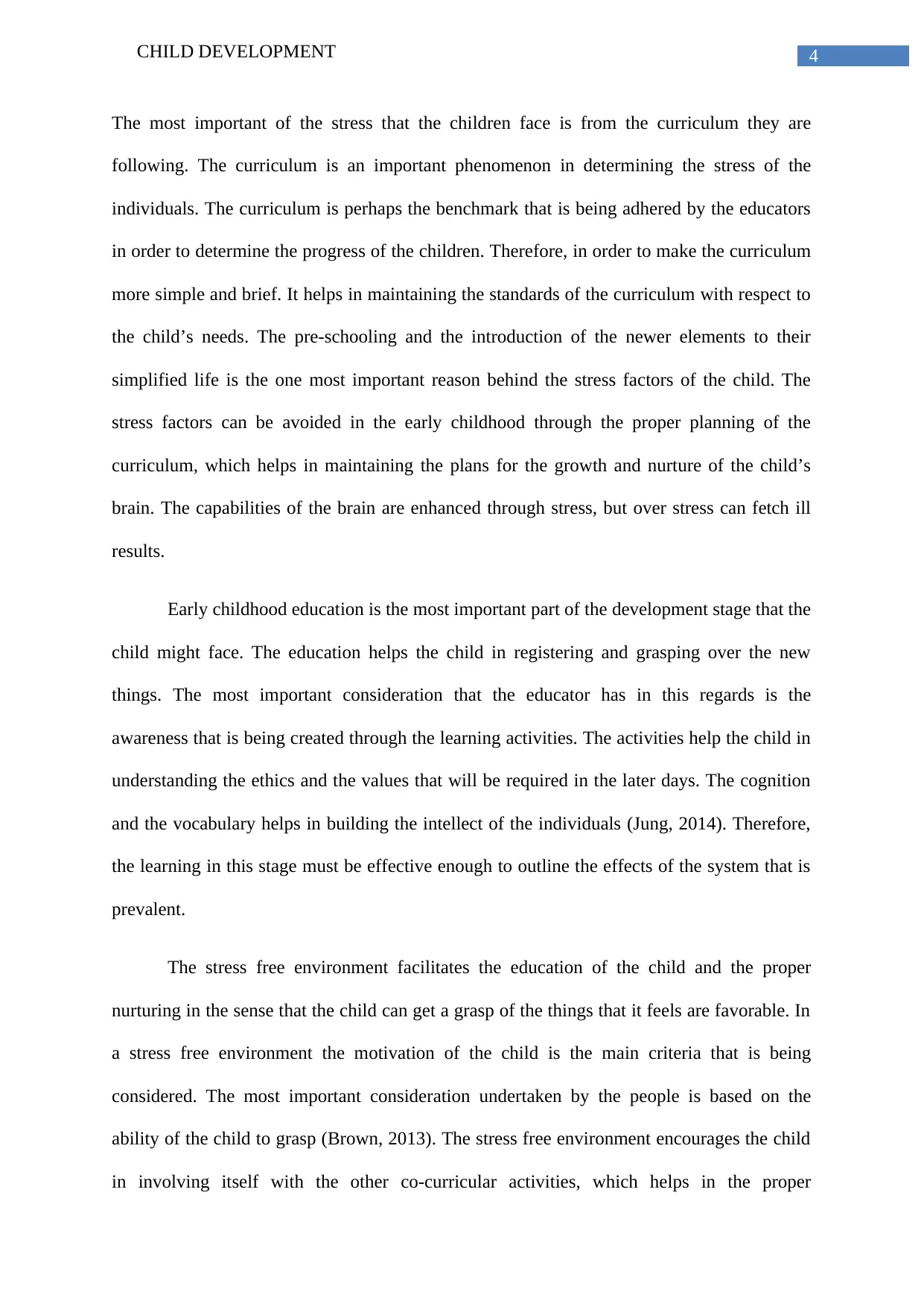
4CHILD DEVELOPMENT
The most important of the stress that the children face is from the curriculum they are
following. The curriculum is an important phenomenon in determining the stress of the
individuals. The curriculum is perhaps the benchmark that is being adhered by the educators
in order to determine the progress of the children. Therefore, in order to make the curriculum
more simple and brief. It helps in maintaining the standards of the curriculum with respect to
the child’s needs. The pre-schooling and the introduction of the newer elements to their
simplified life is the one most important reason behind the stress factors of the child. The
stress factors can be avoided in the early childhood through the proper planning of the
curriculum, which helps in maintaining the plans for the growth and nurture of the child’s
brain. The capabilities of the brain are enhanced through stress, but over stress can fetch ill
results.
Early childhood education is the most important part of the development stage that the
child might face. The education helps the child in registering and grasping over the new
things. The most important consideration that the educator has in this regards is the
awareness that is being created through the learning activities. The activities help the child in
understanding the ethics and the values that will be required in the later days. The cognition
and the vocabulary helps in building the intellect of the individuals (Jung, 2014). Therefore,
the learning in this stage must be effective enough to outline the effects of the system that is
prevalent.
The stress free environment facilitates the education of the child and the proper
nurturing in the sense that the child can get a grasp of the things that it feels are favorable. In
a stress free environment the motivation of the child is the main criteria that is being
considered. The most important consideration undertaken by the people is based on the
ability of the child to grasp (Brown, 2013). The stress free environment encourages the child
in involving itself with the other co-curricular activities, which helps in the proper
The most important of the stress that the children face is from the curriculum they are
following. The curriculum is an important phenomenon in determining the stress of the
individuals. The curriculum is perhaps the benchmark that is being adhered by the educators
in order to determine the progress of the children. Therefore, in order to make the curriculum
more simple and brief. It helps in maintaining the standards of the curriculum with respect to
the child’s needs. The pre-schooling and the introduction of the newer elements to their
simplified life is the one most important reason behind the stress factors of the child. The
stress factors can be avoided in the early childhood through the proper planning of the
curriculum, which helps in maintaining the plans for the growth and nurture of the child’s
brain. The capabilities of the brain are enhanced through stress, but over stress can fetch ill
results.
Early childhood education is the most important part of the development stage that the
child might face. The education helps the child in registering and grasping over the new
things. The most important consideration that the educator has in this regards is the
awareness that is being created through the learning activities. The activities help the child in
understanding the ethics and the values that will be required in the later days. The cognition
and the vocabulary helps in building the intellect of the individuals (Jung, 2014). Therefore,
the learning in this stage must be effective enough to outline the effects of the system that is
prevalent.
The stress free environment facilitates the education of the child and the proper
nurturing in the sense that the child can get a grasp of the things that it feels are favorable. In
a stress free environment the motivation of the child is the main criteria that is being
considered. The most important consideration undertaken by the people is based on the
ability of the child to grasp (Brown, 2013). The stress free environment encourages the child
in involving itself with the other co-curricular activities, which helps in the proper
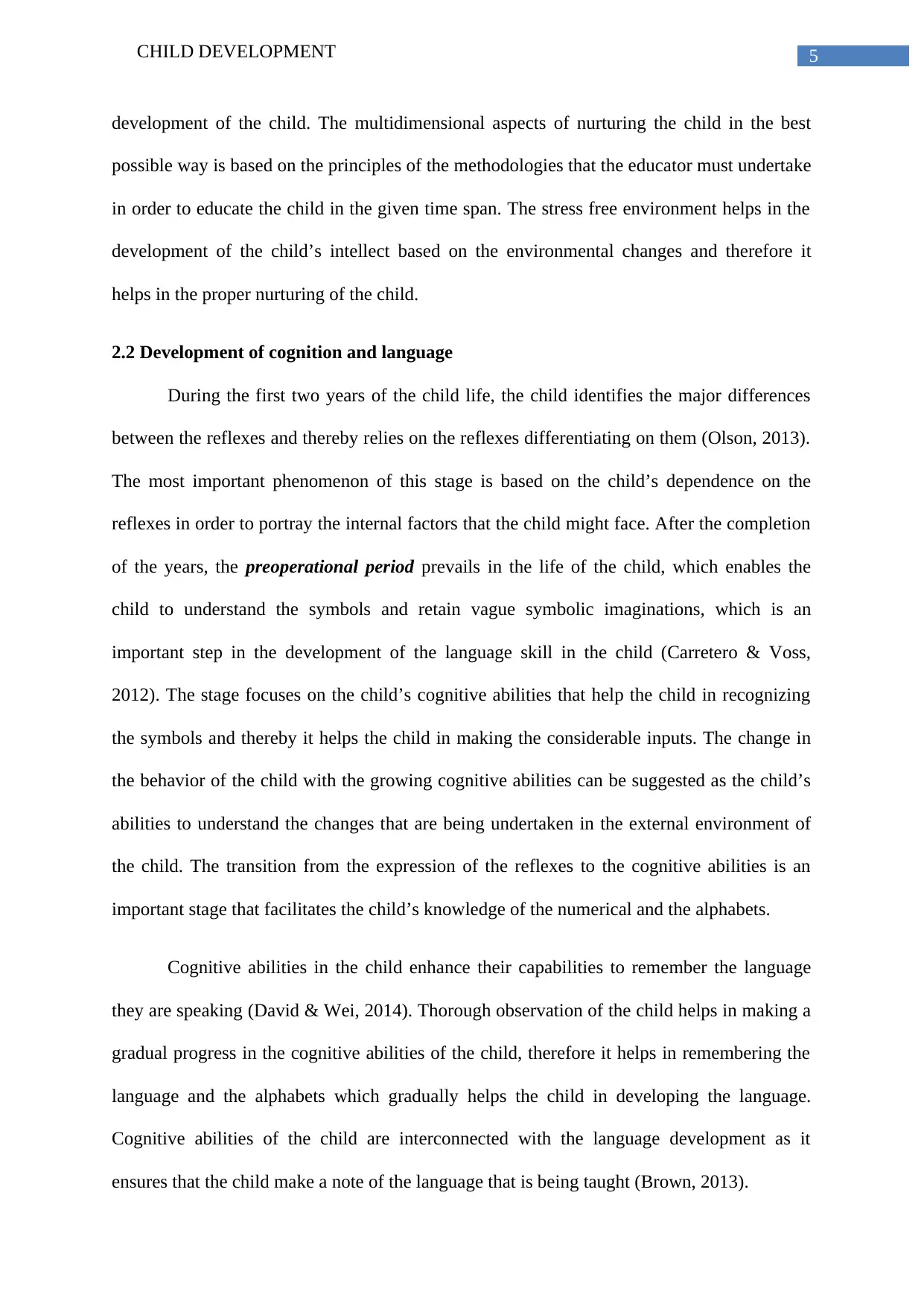
5CHILD DEVELOPMENT
development of the child. The multidimensional aspects of nurturing the child in the best
possible way is based on the principles of the methodologies that the educator must undertake
in order to educate the child in the given time span. The stress free environment helps in the
development of the child’s intellect based on the environmental changes and therefore it
helps in the proper nurturing of the child.
2.2 Development of cognition and language
During the first two years of the child life, the child identifies the major differences
between the reflexes and thereby relies on the reflexes differentiating on them (Olson, 2013).
The most important phenomenon of this stage is based on the child’s dependence on the
reflexes in order to portray the internal factors that the child might face. After the completion
of the years, the preoperational period prevails in the life of the child, which enables the
child to understand the symbols and retain vague symbolic imaginations, which is an
important step in the development of the language skill in the child (Carretero & Voss,
2012). The stage focuses on the child’s cognitive abilities that help the child in recognizing
the symbols and thereby it helps the child in making the considerable inputs. The change in
the behavior of the child with the growing cognitive abilities can be suggested as the child’s
abilities to understand the changes that are being undertaken in the external environment of
the child. The transition from the expression of the reflexes to the cognitive abilities is an
important stage that facilitates the child’s knowledge of the numerical and the alphabets.
Cognitive abilities in the child enhance their capabilities to remember the language
they are speaking (David & Wei, 2014). Thorough observation of the child helps in making a
gradual progress in the cognitive abilities of the child, therefore it helps in remembering the
language and the alphabets which gradually helps the child in developing the language.
Cognitive abilities of the child are interconnected with the language development as it
ensures that the child make a note of the language that is being taught (Brown, 2013).
development of the child. The multidimensional aspects of nurturing the child in the best
possible way is based on the principles of the methodologies that the educator must undertake
in order to educate the child in the given time span. The stress free environment helps in the
development of the child’s intellect based on the environmental changes and therefore it
helps in the proper nurturing of the child.
2.2 Development of cognition and language
During the first two years of the child life, the child identifies the major differences
between the reflexes and thereby relies on the reflexes differentiating on them (Olson, 2013).
The most important phenomenon of this stage is based on the child’s dependence on the
reflexes in order to portray the internal factors that the child might face. After the completion
of the years, the preoperational period prevails in the life of the child, which enables the
child to understand the symbols and retain vague symbolic imaginations, which is an
important step in the development of the language skill in the child (Carretero & Voss,
2012). The stage focuses on the child’s cognitive abilities that help the child in recognizing
the symbols and thereby it helps the child in making the considerable inputs. The change in
the behavior of the child with the growing cognitive abilities can be suggested as the child’s
abilities to understand the changes that are being undertaken in the external environment of
the child. The transition from the expression of the reflexes to the cognitive abilities is an
important stage that facilitates the child’s knowledge of the numerical and the alphabets.
Cognitive abilities in the child enhance their capabilities to remember the language
they are speaking (David & Wei, 2014). Thorough observation of the child helps in making a
gradual progress in the cognitive abilities of the child, therefore it helps in remembering the
language and the alphabets which gradually helps the child in developing the language.
Cognitive abilities of the child are interconnected with the language development as it
ensures that the child make a note of the language that is being taught (Brown, 2013).
⊘ This is a preview!⊘
Do you want full access?
Subscribe today to unlock all pages.

Trusted by 1+ million students worldwide
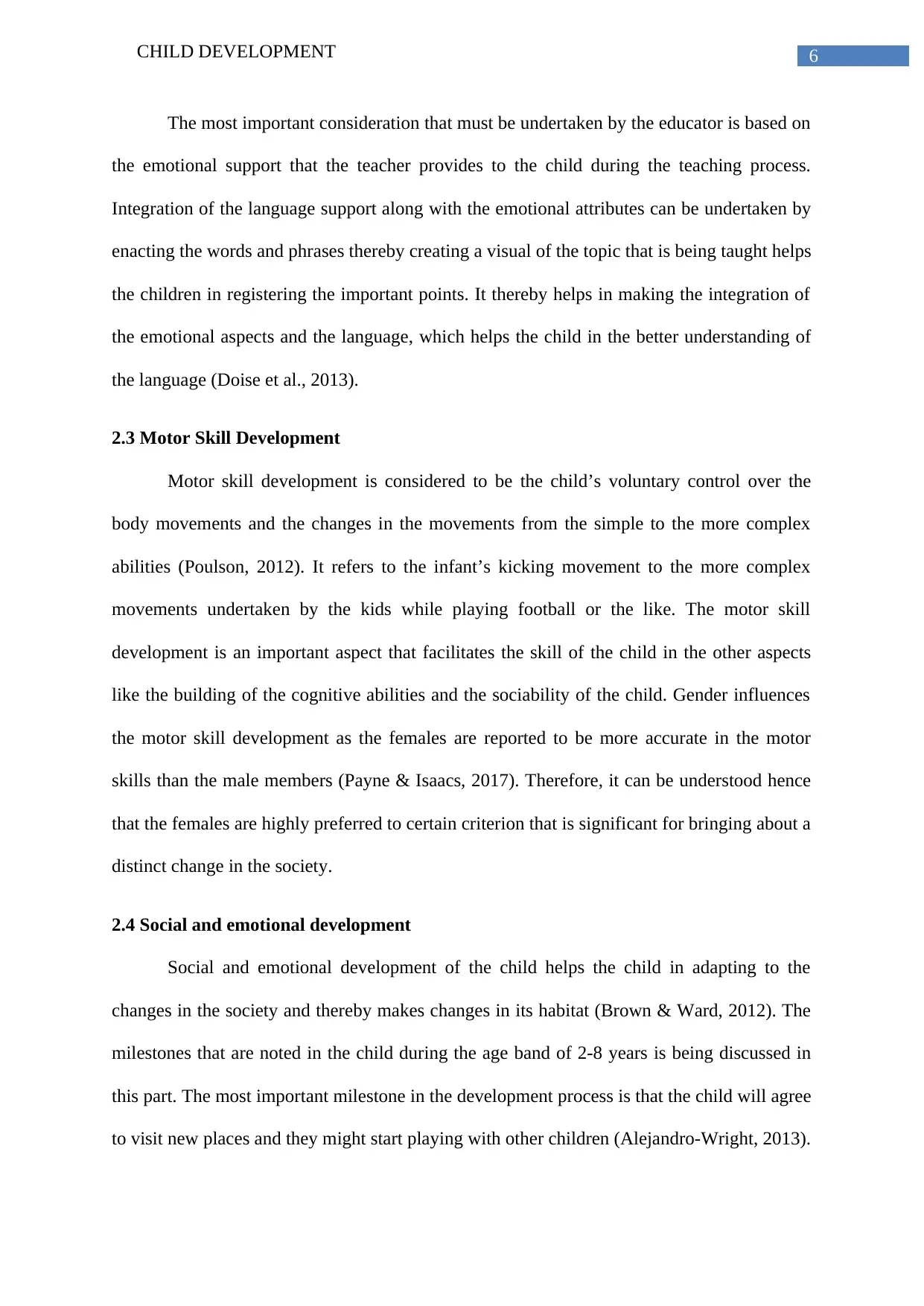
6CHILD DEVELOPMENT
The most important consideration that must be undertaken by the educator is based on
the emotional support that the teacher provides to the child during the teaching process.
Integration of the language support along with the emotional attributes can be undertaken by
enacting the words and phrases thereby creating a visual of the topic that is being taught helps
the children in registering the important points. It thereby helps in making the integration of
the emotional aspects and the language, which helps the child in the better understanding of
the language (Doise et al., 2013).
2.3 Motor Skill Development
Motor skill development is considered to be the child’s voluntary control over the
body movements and the changes in the movements from the simple to the more complex
abilities (Poulson, 2012). It refers to the infant’s kicking movement to the more complex
movements undertaken by the kids while playing football or the like. The motor skill
development is an important aspect that facilitates the skill of the child in the other aspects
like the building of the cognitive abilities and the sociability of the child. Gender influences
the motor skill development as the females are reported to be more accurate in the motor
skills than the male members (Payne & Isaacs, 2017). Therefore, it can be understood hence
that the females are highly preferred to certain criterion that is significant for bringing about a
distinct change in the society.
2.4 Social and emotional development
Social and emotional development of the child helps the child in adapting to the
changes in the society and thereby makes changes in its habitat (Brown & Ward, 2012). The
milestones that are noted in the child during the age band of 2-8 years is being discussed in
this part. The most important milestone in the development process is that the child will agree
to visit new places and they might start playing with other children (Alejandro-Wright, 2013).
The most important consideration that must be undertaken by the educator is based on
the emotional support that the teacher provides to the child during the teaching process.
Integration of the language support along with the emotional attributes can be undertaken by
enacting the words and phrases thereby creating a visual of the topic that is being taught helps
the children in registering the important points. It thereby helps in making the integration of
the emotional aspects and the language, which helps the child in the better understanding of
the language (Doise et al., 2013).
2.3 Motor Skill Development
Motor skill development is considered to be the child’s voluntary control over the
body movements and the changes in the movements from the simple to the more complex
abilities (Poulson, 2012). It refers to the infant’s kicking movement to the more complex
movements undertaken by the kids while playing football or the like. The motor skill
development is an important aspect that facilitates the skill of the child in the other aspects
like the building of the cognitive abilities and the sociability of the child. Gender influences
the motor skill development as the females are reported to be more accurate in the motor
skills than the male members (Payne & Isaacs, 2017). Therefore, it can be understood hence
that the females are highly preferred to certain criterion that is significant for bringing about a
distinct change in the society.
2.4 Social and emotional development
Social and emotional development of the child helps the child in adapting to the
changes in the society and thereby makes changes in its habitat (Brown & Ward, 2012). The
milestones that are noted in the child during the age band of 2-8 years is being discussed in
this part. The most important milestone in the development process is that the child will agree
to visit new places and they might start playing with other children (Alejandro-Wright, 2013).
Paraphrase This Document
Need a fresh take? Get an instant paraphrase of this document with our AI Paraphraser
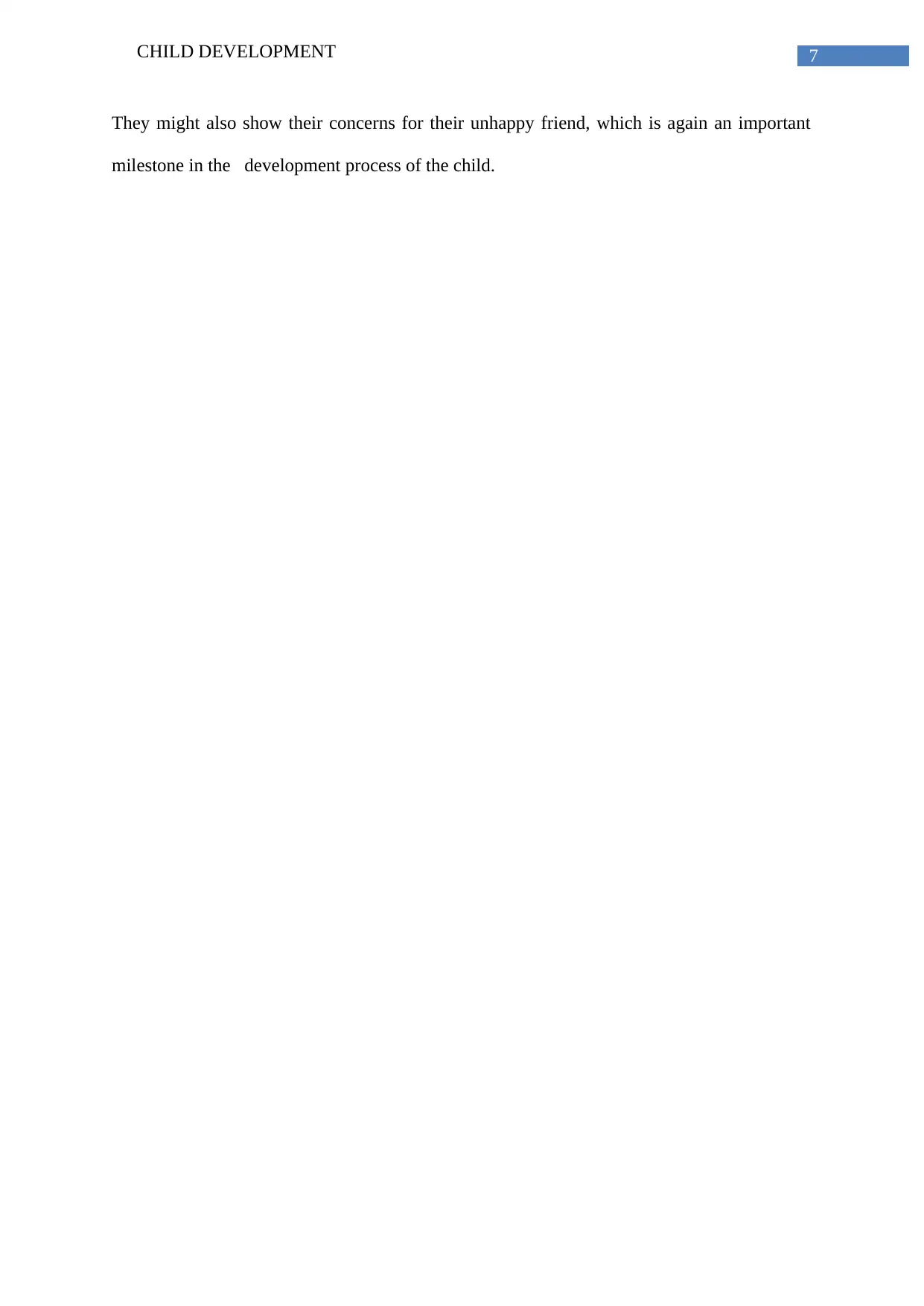
7CHILD DEVELOPMENT
They might also show their concerns for their unhappy friend, which is again an important
milestone in the development process of the child.
They might also show their concerns for their unhappy friend, which is again an important
milestone in the development process of the child.
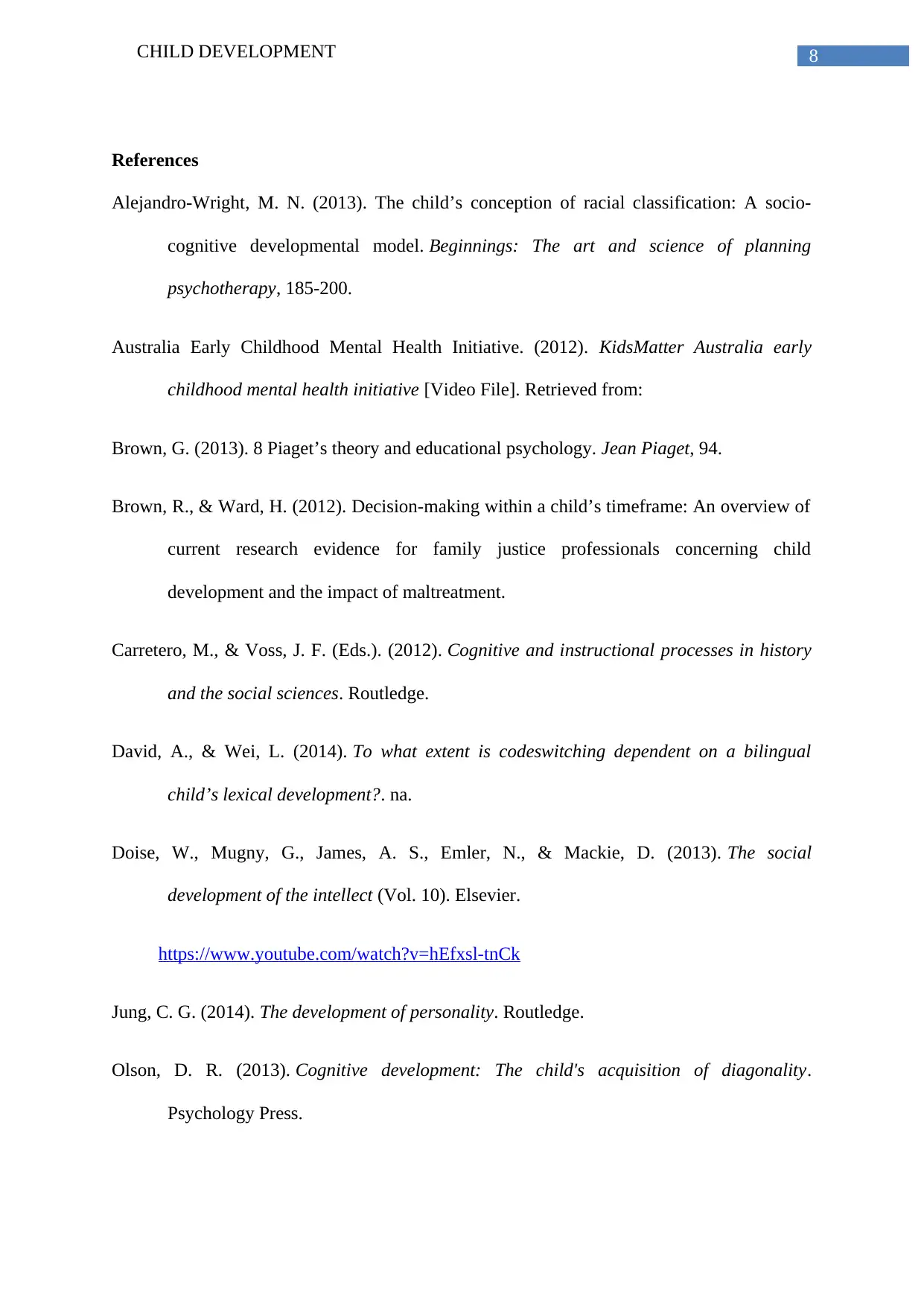
8CHILD DEVELOPMENT
References
Alejandro-Wright, M. N. (2013). The child’s conception of racial classification: A socio-
cognitive developmental model. Beginnings: The art and science of planning
psychotherapy, 185-200.
Australia Early Childhood Mental Health Initiative. (2012). KidsMatter Australia early
childhood mental health initiative [Video File]. Retrieved from:
Brown, G. (2013). 8 Piaget’s theory and educational psychology. Jean Piaget, 94.
Brown, R., & Ward, H. (2012). Decision-making within a child’s timeframe: An overview of
current research evidence for family justice professionals concerning child
development and the impact of maltreatment.
Carretero, M., & Voss, J. F. (Eds.). (2012). Cognitive and instructional processes in history
and the social sciences. Routledge.
David, A., & Wei, L. (2014). To what extent is codeswitching dependent on a bilingual
child’s lexical development?. na.
Doise, W., Mugny, G., James, A. S., Emler, N., & Mackie, D. (2013). The social
development of the intellect (Vol. 10). Elsevier.
https://www.youtube.com/watch?v=hEfxsl-tnCk
Jung, C. G. (2014). The development of personality. Routledge.
Olson, D. R. (2013). Cognitive development: The child's acquisition of diagonality.
Psychology Press.
References
Alejandro-Wright, M. N. (2013). The child’s conception of racial classification: A socio-
cognitive developmental model. Beginnings: The art and science of planning
psychotherapy, 185-200.
Australia Early Childhood Mental Health Initiative. (2012). KidsMatter Australia early
childhood mental health initiative [Video File]. Retrieved from:
Brown, G. (2013). 8 Piaget’s theory and educational psychology. Jean Piaget, 94.
Brown, R., & Ward, H. (2012). Decision-making within a child’s timeframe: An overview of
current research evidence for family justice professionals concerning child
development and the impact of maltreatment.
Carretero, M., & Voss, J. F. (Eds.). (2012). Cognitive and instructional processes in history
and the social sciences. Routledge.
David, A., & Wei, L. (2014). To what extent is codeswitching dependent on a bilingual
child’s lexical development?. na.
Doise, W., Mugny, G., James, A. S., Emler, N., & Mackie, D. (2013). The social
development of the intellect (Vol. 10). Elsevier.
https://www.youtube.com/watch?v=hEfxsl-tnCk
Jung, C. G. (2014). The development of personality. Routledge.
Olson, D. R. (2013). Cognitive development: The child's acquisition of diagonality.
Psychology Press.
⊘ This is a preview!⊘
Do you want full access?
Subscribe today to unlock all pages.

Trusted by 1+ million students worldwide
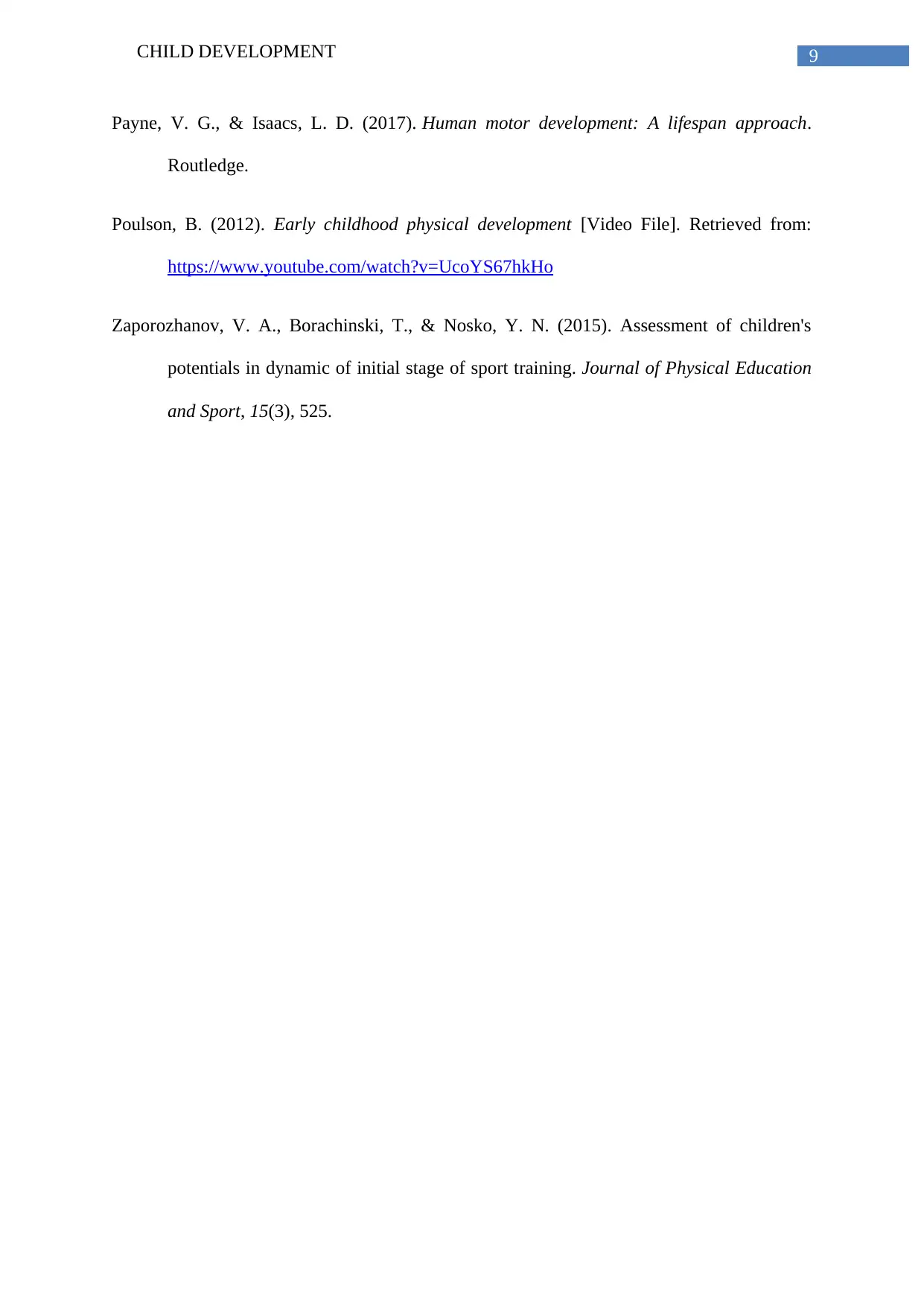
9CHILD DEVELOPMENT
Payne, V. G., & Isaacs, L. D. (2017). Human motor development: A lifespan approach.
Routledge.
Poulson, B. (2012). Early childhood physical development [Video File]. Retrieved from:
https://www.youtube.com/watch?v=UcoYS67hkHo
Zaporozhanov, V. A., Borachinski, T., & Nosko, Y. N. (2015). Assessment of children's
potentials in dynamic of initial stage of sport training. Journal of Physical Education
and Sport, 15(3), 525.
Payne, V. G., & Isaacs, L. D. (2017). Human motor development: A lifespan approach.
Routledge.
Poulson, B. (2012). Early childhood physical development [Video File]. Retrieved from:
https://www.youtube.com/watch?v=UcoYS67hkHo
Zaporozhanov, V. A., Borachinski, T., & Nosko, Y. N. (2015). Assessment of children's
potentials in dynamic of initial stage of sport training. Journal of Physical Education
and Sport, 15(3), 525.
1 out of 10
Related Documents
Your All-in-One AI-Powered Toolkit for Academic Success.
+13062052269
info@desklib.com
Available 24*7 on WhatsApp / Email
![[object Object]](/_next/static/media/star-bottom.7253800d.svg)
Unlock your academic potential
Copyright © 2020–2025 A2Z Services. All Rights Reserved. Developed and managed by ZUCOL.





